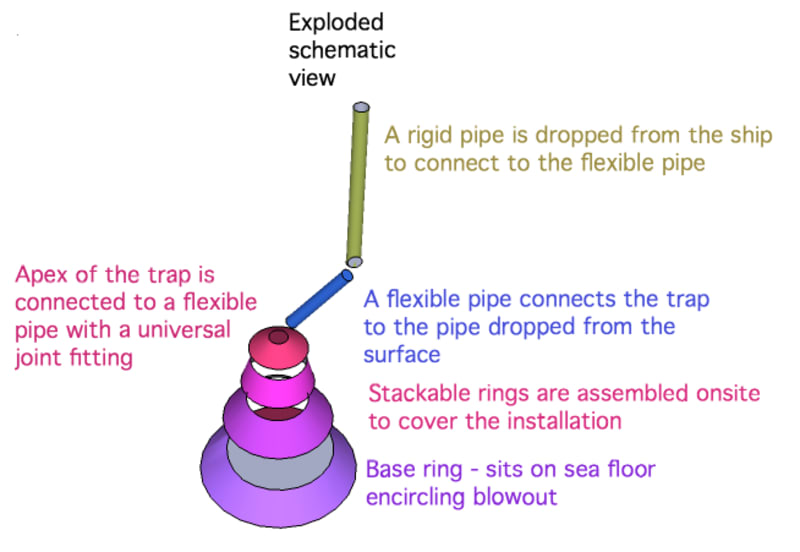This design presents a method for containing oil from a subsea oil blowout. An apparatus constructed from this design will mitigate the spread of oil slicks from subsea oil blowouts, with the benefit of allowing oil exploration to proceed with diminished risk of environmental damage. The method has particular application where coastal wetlands or other delicate ecosystems could be damaged by an oil spill. There currently appears to be no alternative method for containing the oil from such blowouts. The apparatus has market potential in basins subject to offshore oil exploration where deepwater rigs are active.
The design consists of two parts. The first part is a conical-shaped oil trap that is assembled in place just under the ocean surface from a set of floatable, stackable steel rings and then sunk over the source of the oil leak. The rings would be constructed and stored onshore close to areas where deepwater rigs are active. In the event of a blowout, a set of base rigs of a size suitable to encapsulate the equipment in the area of the blowout would be towed to sea and assembled on site. Air chambers in the rings would be flooded to achieve neutral bouyancy, so that multiple rings, separated by gaskets, could be stacked and bolted together, as they are immersed just under the water surface. When assembled, valves on the air chambers located in the rings would be opened and the trap would be sunk so as to lie over the well head and associated sea-bottom production / drilling apparatus, thereby collecting the oil.
The second part consists of standard offshore oil-field drilling ship, from which a pipe would be lowered and connected to the apex of the oil trap. The base of the pipe consists of a flexible section that allows the ship to move relative to the oil trap due to the influence of tides, currents and weather. Oil would either be pumped to the ship or rise naturally from the trap due to its own bouyancy to be proceed on the surface.
There is nothing to prevent a more permanent sub-sea line to be laid from the trap to existing production facilities should the staunching the blowout be impossible, or from assembling a larger, more permanent trap to drop over the initial trap should the use of the trap for an extended period of time be contemplated. When the trap is no longer required, it could the re-floated and disassembled.
The ring sections would be manufactured in a shipyard, with size depending on the dimensions of the installation to cover, while the piping, ship and fittings consist of standard oil field equipment. The apparatus could be rented on a stand-by basis to off-shore rig operators and assembled and placed onsite when required. By allowing exploration to proceed in areas currently off-limits to such activity, the economic value of the proposed apparatus is in the billions of dollars.
Like this entry?
-
About the Entrant
- Name:Peter Walker
- Type of entry:individual
- Hardware used for this entry:MacSoftware used for this entry:Sketchup
- Patent status:none

